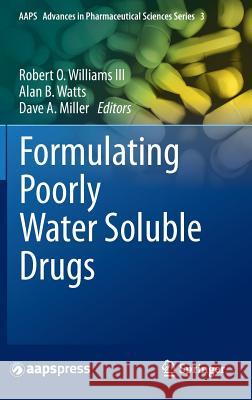Formulating Poorly Water Soluble Drugs » książka
Formulating Poorly Water Soluble Drugs
ISBN-13: 9781461411437 / Angielski / Twarda / 2011 / 648 str.
Formulating Poorly Water Soluble Drugs
ISBN-13: 9781461411437 / Angielski / Twarda / 2011 / 648 str.
(netto: 741,16 VAT: 5%)
Najniższa cena z 30 dni: 771,08 zł
ok. 20 dni roboczych.
Darmowa dostawa!
This volume is intended to provide the reader with a breadth of understanding regarding the many challenges faced with the formulation of poorly water-soluble drugs as well as in-depth knowledge in the critical areas of development with these compounds. Further, this book is designed to provide practical guidance for overcoming formulation challenges toward the end goal of improving drug therapies with poorly water-soluble drugs. Enhancing solubility via formulation intervention is a unique opportunity in which formulation scientists can enable drug therapies by creating viable medicines from seemingly undeliverable molecules. With the ever increasing number of poorly water-soluble compounds entering development, the role of the formulation scientist is growing in importance. Also, knowledge of the advanced analytical, formulation, and process technologies as well as specific regulatory considerations related to the formulation of these compounds is increasing in value. Ideally, this book will serve as a useful tool in the education of current and future generations of scientists, and in this context contribute toward providing patients with new and better medicines.
A pharmaceutical scientist s approach toward solubility enhancement of a poorly water-soluble molecule typically includes detailed characterization of the compound s physiochemical properties, solid-state modifications, advanced formulation design, non-conventional process technologies, advanced analytical characterization, and specialized product performance analysis techniques. The scientist must also be aware of the unique regulatory considerations pertaining to the non-conventional approaches often utilized for poorly water-soluble drugs. One faced with the challenge of developing a drug product from a poorly soluble compound must possess at minimum a working knowledge of each of the abovementioned facets and detailed knowledge of most. In light of the magnitude of the growing solubility problem to drug development, this is a significant burden especially when considering that knowledge in most of these areas is relatively new and continues to develop. There are numerous literature resources available to pharmaceutical scientists to educate and provide guidance toward formulations development with poorly water-soluble drugs; however, a single, comprehensive reference is lacking. Furthermore, without access to a vast journal library, the detailed methods used to implement these approaches are not available. The objective of this volume is therefore to consolidate within a single text the most current knowledge, practical methods, and regulatory considerations pertaining to formulations development with poorly water-soluble molecules.











